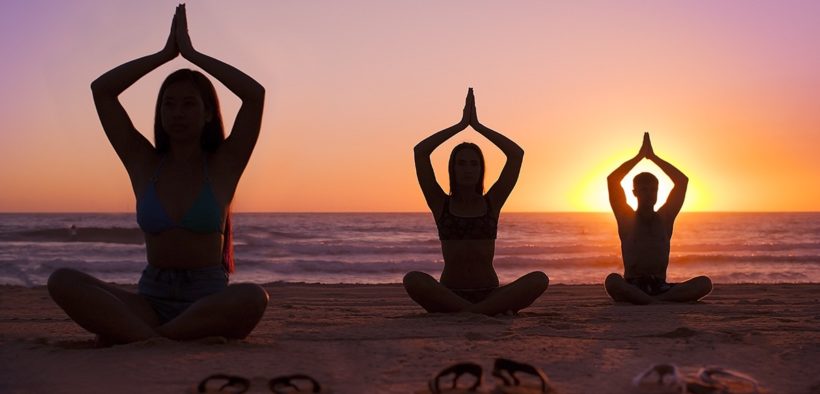Yoga – Shanmukhi Mudra

Shanmukhi mudra Yoga is yogic hand gesture. It represents closing of six gates of perception. These six gates comprises of the mouth, nose, the ears and the eyes. Shanmukhi mudra is a term drawn from Sanskrit language. Shan would mean “six”. Mukhi means “face” or “gate”; and mudra, meaning “gesture,” “mark” or “seal.”
By Dr. Ulhas Ganu
Genesis of Shanmukhi mudra Yoga
The name Shanmukhi Mudra (षण्मुखी) has been derived at as follows:
- Shan (षण्) in Sanskrit means Six
- Mukhi (मुख) in Sanskrit means Mouth
- Mudra has been defined as the activity from Yoga which brings pleasure or pleases (मोदयते is to please) the practitioner.
Shanmukhi Mudra gives a feeling like Meditation in as short as 20 Seconds.
Points to Remember about of Shanmukhi mudra Yoga
- Shanmukhi Mudra gives a very quick relaxation.
- Say “20 Seconds to relaxation” is the word. Ideally Shanmukhi Mudra should not be practiced at a time beyond 30 seconds.
- Practiced for long, say beyond a minute can be risky. This is because, stimulation of trigger points at the outer canthus and inner canthus can stimulate the vagus nerve slowing down the heart rate. Hence patients with cardiovascular problems should not practice Shanmukhi Mudra.

Looking at the convenience of the practitioner one can choose one of the two methods.
Method I:

- Sit and relaxed in a supportive posture like Swastikasana, Veerasana, Vajrasana or Padmasana.
- If you are not comfortable with cross-legged posture, you can sit in a chair, preferably with arms.
- Open your palms with fingers spread as shown in the Figure ……….
- Observe Fig. 2 well. The trigger points viz. Outer Canthus (outer side) and Inner Canthus (inner side). They are located at the two ends of the eyelids palpable with fingers when the eyes are lightly closed (Fig. 2).
- Put the index finger of both palms on the outer canthus of respective closed eyes. Place the middle finger on the inner canthus of both the eyes respectively. Exert a gentle and a very mild, pleasurable pressure.
- Since eyes are closed, the outside world is virtually cut-off. This helps in almost immediately establishing a calming effect on the mind. (Essential Technique).
- This is followed by placing the ring finger (of both hands) adjacent to / outside the nostrils. Do not place the finger on the nostrils. The intention is not to withhold the breath. This references to the nostrils to symbolically indicate the slowed down the breathing. This is because of the meditative posture. (Traditional Technique).
- Place the little fingers of both palms at the outer point of the lips. This again symbolizes the nonverbal, meditative state. (Traditional Technique).
- Now put both thumbs in the respective ears, plugging them. This restricts noise from entering the ears and disturbing us (Essential Technique).
Method II:
- Begin by plugging the ears with your Thumbs (Essential Technique)
- Then close the eyes gently. Put the index finger and the middle finger on the outer and the inner canthus (points at extremities) of both the eyes respectively. Exert very mild, pleasurable pressure (Essential Technique). Since the ears are plugged and eyes are closed, outside world is visually cut-off. This helps in initiating the calming of the mind.
- The use of Ring Finger and Little Finger is Symbolic. These can be kept anywhere on the cheek. The placement may not necessarily in line with the nostrils and the lips (Traditional Technique).

The closing the eyes and ears uses ‘Essential Technique’. And the symbolic closing of nostrils and the lips uses ‘Traditional Technique’. Shutting out disturbing sounds and visuals allows being in peace with our inner self. This can be achieved within half a minute.
Being in Shanmukhi Mudra for as short as half a minute also gives tremendous relaxation. Practicing Shanmukhi Mudra just before Savasana or Meditation helps going into them quickly for deriving optimum benefits. Shanmukhi Mudra is a meditative posture. This can help calm down the mind and lower blood pressure (precaution: as usual it is not a substitute to any therapy).
Caution: Pressure points at the inner canthus and the outer canthus are trigger points for vagus nerve. It is suggested that since stimulation of vagus nerve slows down the heart rate, people with cardiac problem- especially with congestive heart failure or those on the pacemaker are best advised to not to practice Shanmukhi Mudra. It must be proper or talk to physician before practicing this Mudra.
Contraindications about of Shanmukhi mudra Yoga:
- People with severe cardiac problem should consult their physician about Shanmukhi Mudra.
- people with cardiac problem; especially with congestive heart failure or those on the pacemaker are best advised to not to practice Shanmukhi Mudra.
- Since it induces tranquilizing effect and causes drowsiness, people driving a vehicle or working on moving machines should avoid practicing Shanmukhi Mudra during work. On the contrary, if they can keep a fair amount of gap between the Mudra and work then it can be used advantageously for relaxation refreshing the mind.
Benefits of Shanmukhi mudra Yoga:
- Shanmukhi Mudra reduces stress instantly. Hence it helps in reducing cardiac rate and lower blood pressure. Patients with hypertension can derive maximum benefit out of it. However, never use it instead of medication.
- If practiced during office work it can give instant relaxation and work vigorously.
- Those working on computers or on tough problems or working with figure such as in accounting can get excellent relaxation which they can use to produce better output.
- Artist and creative people can be benefited by getting good ideas by practicing this Mudra.
- Senior managers, sales personnel and industrialists are also likely to be benefited by the practice of this Mudra.
- If practiced before Shavasana, it helps one go quickly into Shavasana compounding the benefits manifold.
- It also helps on enter into meditation quickly.
Positivity:
- Practice of Shanmukhi Mudra produces peace of mind to such an extent that the practitioner gets instant benefit similar to that obtained after sound sleep.
- This recharges the mind and helps focus on work with more zest.
















